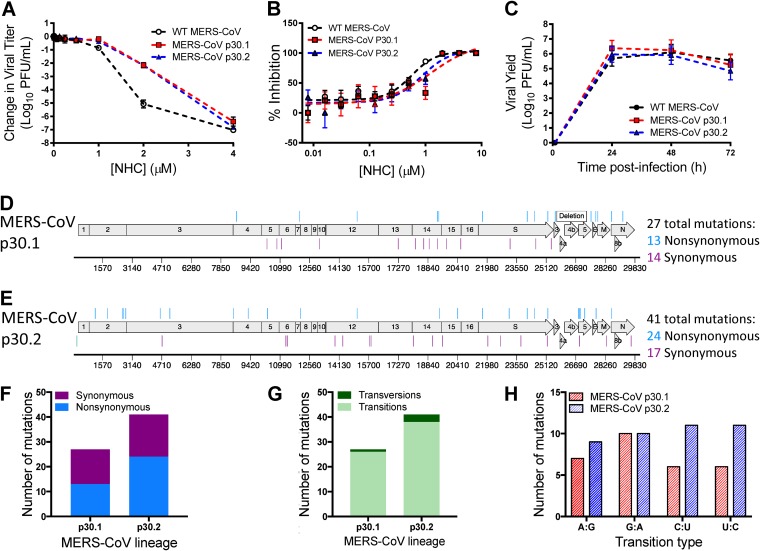FIG 7.
Resistance and mutational profiles of MERS-CoV after 30 passages in the presence of NHC. (A) Changes in viral titers relative to vehicle controls after treatment with NHC for WT MERS-CoV passaged 30 times in the absence of drug, MERS-CoV p30.1, and MERS-CoV p30.2 relative to vehicle controls after treatment with NHC. Both MERS-CoV p30.1 and p30.2 were less sensitive to NHC than WT MERS-CoV. The data represent the results of 2 independent experiments, each with 3 replicates. The error bars represent SEM. (B) Changes in viral titer data from panel A represented as percentages of that of vehicle control. WT MERS-CoV, EC90 = 1.31 μM; MERS-CoV p30.1, EC90 = 3.04 μM; MERS-CoV p30.2, EC90 = 2.12 μM. (C) Replication kinetics of NHC passage viruses. WT MERS-CoV, MERS-CoV p30.1, and MERS-CoV p30.2 replicated with similar kinetics and reached similar peak titers. The data represent the results of 2 independent experiments, each with 3 replicates. The error bars represent SEM. (D) MERS-CoV p30.1 accumulated 27 total mutations across the genome. Of these mutations, 14 were synonymous and 13 were nonsynonymous. (E) MERS-CoV p30.2 accumulated 41 total mutations. Of these mutations, 17 were synonymous and 24 were nonsynonymous. (F) Both MERS-CoV p30.1 and p30.2 accumulated similar numbers of nonsynonymous and synonymous changes during passage. (G) MERS-CoV p30.1 and p30.2 acquired predominantly transitions. (H) Types of transition mutations present in each lineage across passage. MERS-CoV p30.1 acquired more G:A transitions, whereas MERS-CoV p30.2 acquired similar numbers of each transition type.

